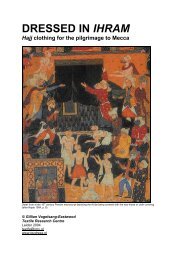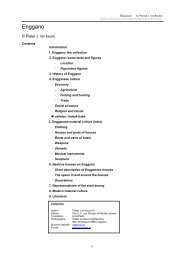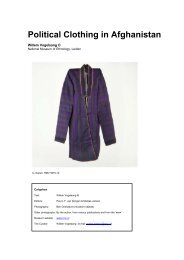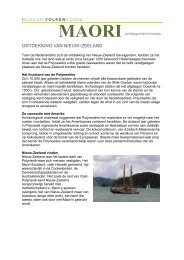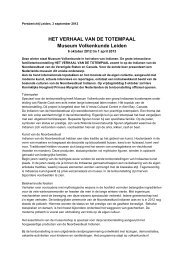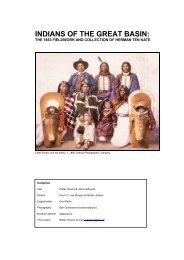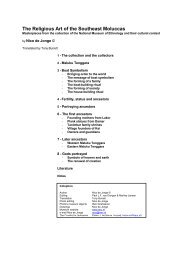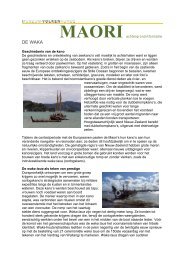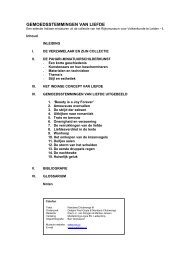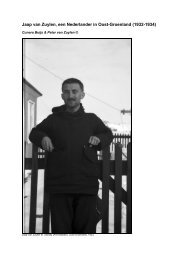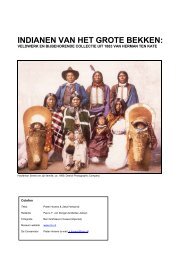Accidental acquisitions: - Museum Volkenkunde
Accidental acquisitions: - Museum Volkenkunde
Accidental acquisitions: - Museum Volkenkunde
Create successful ePaper yourself
Turn your PDF publications into a flip-book with our unique Google optimized e-Paper software.
<strong>Accidental</strong> <strong>acquisitions</strong>:<br />
The nineteenth-century Korean collections<br />
in the National <strong>Museum</strong> of Ethnology, Part 1<br />
Fan, RMV 1-4176<br />
Colophon<br />
Text Ken Vos ©<br />
Editors<br />
Photography<br />
<strong>Museum</strong> website<br />
The Cuartor<br />
Paul L.F. van Dongen & Marlies Jansen<br />
Ben Grishaaver<br />
www.rmv.nl<br />
Ken Vos (e-mail: mailto:ken@rmv.nl)
ACCIDENTAL ACQUISITIONS: THE EARLY KOREAN COLLECTIONS IN THE NATIONAL MUSEUM OF ETHNOLOGY, PART 1<br />
© KEN VOS<br />
Digital publications of the National <strong>Museum</strong> of Ethnology<br />
Early contacts<br />
Although, according to their acquisition data, the Korean collections in the National <strong>Museum</strong> of<br />
Ethnology are the oldest in Europe, they have rarely played a central role in the history of the<br />
collections held in the National <strong>Museum</strong> of Ethnology (Rijksmuseum voor <strong>Volkenkunde</strong>,<br />
hereafter referred to as RMV). Until the late nineteenth century, no Korean items had been<br />
acquired directly by the Dutch from the peninsula itself. The principal reason for this is that the<br />
Chosŏn 1 government, in its isolationist policy, had no desire for diplomatic relations with any<br />
nation with which it shared no direct political interest. Relations with China and Japan were<br />
maintained, but even these were both limited and heavily regulated. In fact, until 1876, the<br />
Korean government did not permit its citizens to travel abroad, except on rare embassies to<br />
these neighbouring states. Moreover, all non-Chinese foreigners found on Korean soil were<br />
immediately arrested and placed in custody, to be sent back to their country of origin. A wellknown<br />
episode during this isolationist period is that of Hendrik Hamel 2 and his companions, who<br />
were shipwrecked on the coast of Cheju Island in 1653.<br />
In general, it can be said that, except for a few exceptions in the twentieth century, no<br />
substantial systematic collections of Korean objects, assembled by either individuals or<br />
museum professionals, are to be found in Europe. The same is true for the Netherlands and the<br />
National <strong>Museum</strong> of Ethnology. One notable exception is the 666 series acquired from Friedrich<br />
Kraus 3 in 1888. Most of the nineteenth-century <strong>acquisitions</strong> can be characterized as 'accidental'.<br />
Until the 1870s the only direct contact between Europeans and Koreans occurred in Nagasaki,<br />
in Japan. All foreigners found to be in Japan illegally were sent to Nagasaki, where the central<br />
government had also concentrated most of the foreign trade. Koreans who had accidentally<br />
landed in Japan, usually because they had been shipwrecked, were housed in the trading office<br />
of the lord of Tsushima. The feudal domain of Tsushima, consisting mainly of the eponymous<br />
islands located between Japan and Korea, had the Japanese monopoly of the trade between<br />
both countries. Whereas the Koreans, until their transfer to Tsushima, were free to move about<br />
in Nagasaki, the Dutch were not. Groups of shipwrecked Koreans sometimes had to wait for<br />
months before they could board ship for their own country. Most Korean objects acquired by the<br />
Dutch therefore originate from the few personal encounters arranged with Koreans in Nagasaki,<br />
or from Japanese sources in that city. It goes without saying that Koreans who were stranded in<br />
Japan usually had very few personal belongings with them.<br />
The earliest Korean objects to be collected are to be found in what is known as the 360 series,<br />
transferred in 1883 from the Royal Cabinet of Curiosities, which had closed eight years before.<br />
The earliest recorded Korean object in this collection is 360-1042, a rare shaman's hat, acquired<br />
from a certain (Mr.?) Sanders, probably in 1816.<br />
RMV 360-1042<br />
1
ACCIDENTAL ACQUISITIONS: THE EARLY KOREAN COLLECTIONS IN THE NATIONAL MUSEUM OF ETHNOLOGY, PART 1<br />
© KEN VOS<br />
Digital publications of the National <strong>Museum</strong> of Ethnology<br />
It is followed by the objects in the ranges 2902-69 and 3174-75, all collected by Jan Cock<br />
Blomhoff 4 in Japan before 1823. A small number of other items also originate from <strong>acquisitions</strong><br />
from the Royal Cabinet, including an interesting model of a ship.<br />
RMV 360-7727<br />
However, these five items do not have a clear provenance, apart from the fact that they were<br />
acquired by the Cabinet before its closure in 1875. One item, 360-7436, was registered as<br />
being Korean, but nothing else in its form or technique confirms this is actually the case. The<br />
forty-five extant numbers deriving from the Siebold collection (series 1) were probably all<br />
acquired by Philipp Franz von Siebold 5 between 1823 and 1829 in Nagasaki.<br />
Portrait of Philipp Franz von Siebold<br />
(Lithograph by E. Chiossone, 1875)<br />
Although Siebold's descriptions tell us solely about the conditions under which these<br />
<strong>acquisitions</strong> were made, we can only assume that the other Dutchmen on Dejima 6 acquired<br />
their objects in a similar way.<br />
2
ACCIDENTAL ACQUISITIONS: THE EARLY KOREAN COLLECTIONS IN THE NATIONAL MUSEUM OF ETHNOLOGY, PART 1<br />
© KEN VOS<br />
Digital publications of the National <strong>Museum</strong> of Ethnology<br />
The series numbered 1 and 360 cover all <strong>acquisitions</strong> made during the period of Korea's<br />
isolationist policy. After the country was opened up to trade in 1876, the Dutch never maintained<br />
any significant diplomatic presence in the country until the Korean War of 1950-53. Most<br />
<strong>acquisitions</strong> since 1876 arrived through foreign travellers and foreign dealers (series 412, 520,<br />
679, 681, 1070). More information about these <strong>acquisitions</strong> will be given in the next instalments<br />
of this web publication. In total, the nineteenth-century collections hold about 495 numbers.<br />
Siebold and his meetings with Koreans<br />
In the section devoted to Korea in Philipp Franz von Siebold's Nippon, he mentions several<br />
encounters with Koreans in Nagasaki. One meeting, mentioned specifically, is dated 17 March<br />
1828. Through his Japanese contacts, Siebold was able to secure permission to visit a group of<br />
Koreans at the Tsushima trading office.<br />
Korean merchants and seamen; illustration from Nippon VII, tabula II.<br />
Thirty-six people, identified as fishermen, sailors, merchants and travellers, were present at the<br />
time. The members of the group, which also included women and children, were all crew and<br />
passengers of three ships that had sailed from Chŏllado 7 .<br />
It was Siebold's intention to obtain information on their physical characteristics, customs,<br />
language, writing system and so on. A few of them had been selected by Siebold's host for<br />
conversation through an interpreter: two merchants, a teacher, a businessman, a skipper, and a<br />
cabin boy. They had been chosen for their diversity and their usefulness as informants.<br />
Draughtsman Carl Hubert de Villeneuve's 8 portraits, and painter Kawahara Keiga's 9 pictures of<br />
objects made on this occasion, were eventually used for an album (inv.no. 1-4491) and formed<br />
the basis for illustrations in the book.<br />
A Korean merchant, a master and a ship boy; illustrations from album RMV 1-4491,<br />
which were used as originals for the lithographies in Nippon.<br />
3
ACCIDENTAL ACQUISITIONS: THE EARLY KOREAN COLLECTIONS IN THE NATIONAL MUSEUM OF ETHNOLOGY, PART 1<br />
© KEN VOS<br />
Digital publications of the National <strong>Museum</strong> of Ethnology<br />
Some of the group are identified by name. Unfortunately, although Siebold made some effort to<br />
describe and transliterate spoken and written Korean, using Japanese sources and direct<br />
observation, his transcriptions seem quite inconsistent and inaccurate. A list of Korean words<br />
included in the book confirms this. One of the merchants was named 'Ho sa tsiêm' (identified in<br />
the Japanese translation as Hŏ Sa-ch'ŏm), whereas the teacher was identified as 'Kum tsiun'.<br />
(Kim Ch'i-yun in the translation).<br />
Portrait of Hŏ Sa-ch'ŏm.<br />
The others remain anonymous. As was customary, gifts were exchanged, and Siebold<br />
presented alcoholic beverages and several metres of cloth. In return, he was given some<br />
manuscripts, scroll paintings, a small table, several jars, dishes, some clothing and accessories.<br />
Unfortunately no itemized list is provided, so we cannot deduce which of these objects<br />
correspond to the existing objects in series 1. However, we do know that there are no tables in<br />
this collection. At a later date the Koreans also sent Siebold gifts, for example, 'trifles, examples<br />
of their writing and farewell letters'. In the same paragraph, Siebold specifically mentions<br />
another landscape painting, 'executed in the old Chinese manner'. Similarly, these items cannot<br />
be traced in the museum's collection.<br />
In the same chapter, Siebold gives us a relatively detailed account of the shipwrecked Koreans'<br />
demeanour, dress and accessories.<br />
Coat and trousers, RMV 1-4169 and 4170 Fan, RMV 1-4176<br />
4
ACCIDENTAL ACQUISITIONS: THE EARLY KOREAN COLLECTIONS IN THE NATIONAL MUSEUM OF ETHNOLOGY, PART 1<br />
© KEN VOS<br />
Digital publications of the National <strong>Museum</strong> of Ethnology<br />
It seems that Siebold had difficulty in distinguishing cotton, linen and ramie (a textile made from<br />
vegetable fibres). His views of the Koreans consist mainly of comparisons with Japanese,<br />
Chinese and Europeans. His stereotyping of racial characteristics, and his idea that these are in<br />
some way connected to social class, are very amusing. He specifically mentions that Hŏ, in<br />
response to a question of Siebold's, indicates that Kim has the typical physiognomy of a<br />
'commoner'. This passage shows that both nineteenth-century Koreans and Germans were<br />
preoccupied with class distinctions. However, most of the information on Korea that Siebold<br />
gives in Nippon was picked up from Japanese locals in the Japanese trading post just north of<br />
the port city of Pusan (Jap.: Fusankai) and from a Japanese publication, Chōsen monogatari<br />
(Edo, 1791), compiled by Kimura Rikiemon, partly based on seventeenth-century accounts of<br />
Japanese sailors.<br />
Chinese map of Korea, illustration from Nippon, VII, tabula XI<br />
Naturally, Siebold's own observations are the most interesting because, up to that time, there<br />
had been no other first-hand European-language accounts of Korea or Korean culture, other<br />
than Hamel's Journael, Van de ongeluckige Reyse 't Jacht de Sperwer, Varende van Batavia na<br />
Tyowan en Fermosa in 't Jaer 1653 (Amsterdam, 1668). Some of these observations are quite<br />
informative, for example on the way a Korean ship is built, or on the way in which morning<br />
prayers with drum accompaniment are conducted. Although Chinese chess (Korean: changgi) is<br />
properly identified, even as early as Siebold's time, people apparently thought that go (Korean:<br />
paduk) was originally a Japanese game, rather than Chinese.<br />
5
ACCIDENTAL ACQUISITIONS: THE EARLY KOREAN COLLECTIONS IN THE NATIONAL MUSEUM OF ETHNOLOGY, PART 1<br />
© KEN VOS<br />
Digital publications of the National <strong>Museum</strong> of Ethnology<br />
Four Koreans playing go, illustration from the album of Von Siebold, RMV 1-4491<br />
A separate chapter is devoted to the Korean language and writing system, since they were<br />
completely unknown in Europe. Siebold was probably ignorant of the fact that han'gŭl, the<br />
Korean script, was an artificially developed alphabet, a syllabary as he persistently calls it, in the<br />
same way one would call Japanese kana script a syllabary. In 1832 the orientalist Julius<br />
Klaproth, at the Institut Royal in Paris, wrote a translation of Hayashi Shihei's 10 Sankoku tsūran<br />
zusetsu (1786) in which han'gŭl was for the first time presented to Europeans. However,<br />
Siebold complains that in 1824 he had already sent a similar syllabary to the Dutch East Indies<br />
government in Batavia, with the request that it should be sent to the Insitut Royal. This syllabary<br />
was apparently sent, but lost, since according to Siebold, Klaproth's reports on Korea were not<br />
appreciated by the Royal Netherlands Institute. Nonetheless it is again published in Nippon. In<br />
addition, his accompanying list of Korean and Sino-Korean words contain a great number of<br />
inaccuracies.<br />
Scriptura Cooraiana, Korean syllables- and characters; Nippon VII, tabula X<br />
6
ACCIDENTAL ACQUISITIONS: THE EARLY KOREAN COLLECTIONS IN THE NATIONAL MUSEUM OF ETHNOLOGY, PART 1<br />
© KEN VOS<br />
Digital publications of the National <strong>Museum</strong> of Ethnology<br />
The objects<br />
The Korean sections of the Blomhoff and Siebold collections are mainly of a similar nature.<br />
Most of the items are everyday, personal belongings brought along for a short journey or saved<br />
from a wreckage. As such, they are not really representative on any wider scale of the Korean<br />
material culture of that time. Interestingly, Siebold succeeded in having several paintings made<br />
locally by some of the Koreans he met (six in total; nos 1-1356 through -1360 and 1-1362).<br />
RMV 1-1356, 1-1360 and 1-1362<br />
We know these were locally made, because all the signatures contain the prefix "Chosŏn", the<br />
contemporary name for Korea. An exception is probably no. 1-2589, a sample of wood which<br />
most likely originates from a Japanese collection.<br />
RMV 1-2589<br />
7
ACCIDENTAL ACQUISITIONS: THE EARLY KOREAN COLLECTIONS IN THE NATIONAL MUSEUM OF ETHNOLOGY, PART 1<br />
© KEN VOS<br />
Digital publications of the National <strong>Museum</strong> of Ethnology<br />
Looked upon as a whole, most of the objects seem to be of mediocre quality by Korean<br />
standards. Three pages of illustrations (tab. XII, XIII and XIV) can be found in Nippon, and<br />
include items which are no longer in the collection.<br />
Interestingly enough, one object from the Blomhoff collection, 360-2959, can be found on plate<br />
XIII.<br />
RMV 360-2959<br />
Where four of the objects included are concerned, their locus of production is actually<br />
Japanese, but they can be considered as integral to the Korean collection. These are album<br />
item no. 1-4491 and two paintings (360-7757 and -7758), all mentioned above, containing<br />
depictions (produced by Keiga or his school, and De Villeneuve) of Koreans and a Korean ship.<br />
RMV 360-7757 and 7758.<br />
8
ACCIDENTAL ACQUISITIONS: THE EARLY KOREAN COLLECTIONS IN THE NATIONAL MUSEUM OF ETHNOLOGY, PART 1<br />
© KEN VOS<br />
Digital publications of the National <strong>Museum</strong> of Ethnology<br />
One other item, an undated printed version of the classical Chinese teaching book, the<br />
Qianziwen (Korean Ch'ŏnjamun), the "Thousand-character book" is also originally Japanese,<br />
but also contains printed han'gŭl script for the Korean pronunciation of the Chinese characters,<br />
whereas Japanese katakana 11 script has been added by hand.<br />
RMV 1-4334<br />
9
ACCIDENTAL ACQUISITIONS: THE EARLY KOREAN COLLECTIONS IN THE NATIONAL MUSEUM OF ETHNOLOGY, PART 1<br />
© KEN VOS<br />
Digital publications of the National <strong>Museum</strong> of Ethnology<br />
Literature<br />
Hamel, Hendrik<br />
1668 Journael, Van de ongeluckige Reyse 't Jacht de Sperwer, Varende van Batavia na<br />
Tyowan en Fermosa in 't Jaer 1653. en van daer na Japan daer Schipper op was Reynier<br />
Egbertsz van Amsterdam. Beschrijvende hoe het Jacht door storm en onweer vergaen is veele<br />
Menschen verdroncken en gevangen sijn: Mitsgaders wat haer in 16. Jaren tijdt wedervaren is<br />
en eyndelijck hoe noch eenighe van haer in 't Vaderlandt zijn aen gekomen Anno 1668. in de<br />
Maendt July. Gillis Joosten Saagman, Amsterdam.<br />
Kodae Minjok Munhwa Yŏn'guso (ed.)<br />
1980 Han'guk minsok taegam 2. Ilsang saenghwal, ŭishikchu: 172-3. Kodae Minjok Munhwa<br />
Yŏn'guso, Seoul.<br />
Schmeltz, J.D.E.<br />
1891 Die Sammlungen aus Korea im ethnographischen Reichsmuseum zu Leiden in: J.D.E.<br />
Schmeltz, red. - Internationales Archiv für Ethnographie Vol. IV: 45-65, 105-38. P.W.M.<br />
Trap, Leiden.<br />
Philipp Franz von Siebold<br />
1832-54 Nippon. Archiv zur Beschreibung von Japan und dessen Neben- und Schütländern,<br />
Vol. VII: 153-61, Leiden.<br />
The Korea Foundation (ed.)<br />
1992 Han'guk munhwajae. Yurŏp pakmulgwan sojang: 9-20. The Korea Foundation, Seoul.<br />
Vos, K.<br />
1987 Officiersmantel met helm. In: Dongen, P.L.F. van et al, red. - Topstukken uit het<br />
Rijksmuseum voor <strong>Volkenkunde</strong>: 50-1. Rijksmuseum voor <strong>Volkenkunde</strong>, Leiden.<br />
Walraven, Boudewijn C.A.<br />
1983 Korean genre paintings in the Netherlands and around the world. In: Korean National<br />
Commission for UNESCO, red. - Korean Painting: 67-81. Si-sa-yong-sa Publishers,<br />
Inc., Seoul.<br />
10
ACCIDENTAL ACQUISITIONS: THE EARLY KOREAN COLLECTIONS IN THE NATIONAL MUSEUM OF ETHNOLOGY, PART 1<br />
© KEN VOS<br />
Digital publications of the National <strong>Museum</strong> of Ethnology<br />
Notes<br />
1 Chosŏn (1392-1910) is the name chosen for Korea by the dynasty founded in 1392 by General Yi Sŏng-gye (1335-<br />
1408, King T'aejo, reigned 1392-8) after deposing the last Koryŏ King, Kongyang. 'Chosŏn' referred to a prehistoric<br />
mythical Korean kingdom of the same name.<br />
2 Hendrik Hamel (1630-92) stayed in Korea for thirteen years before escaping to Dejima.<br />
3 Friedrich Kraus stayed in Korea from 1885 to 1888 in the service of the Korean government. His collection will be<br />
described in the next instalment of the nineteenth-century Korean Collections.<br />
4 Jan Cock Blomhoff (1779-1853) stayed on Dejima from 1809-13 as warehouse master, and from 1817-23 as chief<br />
merchant.<br />
5 Philipp Franz von Siebold (1797-1866), founder of the National <strong>Museum</strong> of Ethnology, stayed on Dejima from 1823<br />
until 1829.<br />
6 Dejima (old spelling: 'Deshima') was the artificial island in Nagasaki Bay where the Dutch had their trading<br />
establishment from 1641 to 1856.<br />
7 Chŏllado is the name of a province located in Korea's Southwest, an administrative unit in use during most of the<br />
Chosŏn period.<br />
8 Carl Hubert de Villeneuve (1800-74) was a Dutch painter who was asked by Siebold to come to Dejima from Batavia in<br />
1825 and who was to remain there until 1829.<br />
9 Kawahara Keiga (1786? - after 1860) was appointed as painter by the Nagasaki governors, to produce works<br />
commissioned by the Dutch on Dejima.<br />
10 Hayashi Shihei (1738-93) was an important Nagasaki scholar who published works on Japan and its relations with<br />
neighbouring countries.<br />
11 Katakana script is one of two phonetic syllabaries (the other being hiragana) used next to, or instead of, Chinese<br />
characters in the Japanese writing system.<br />
11



